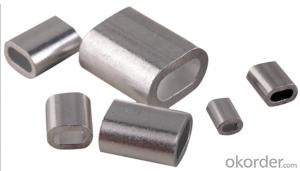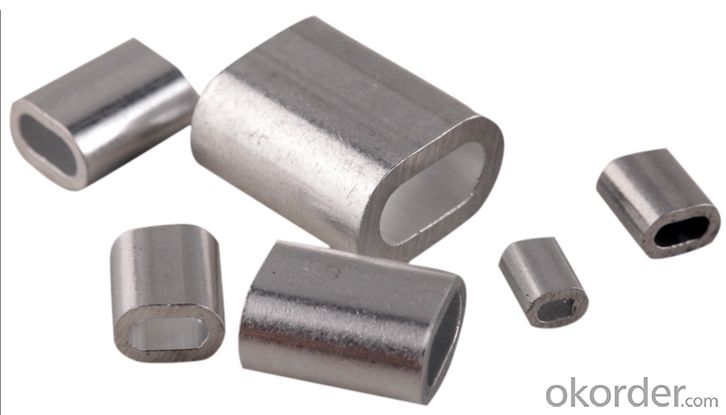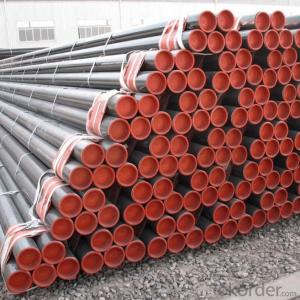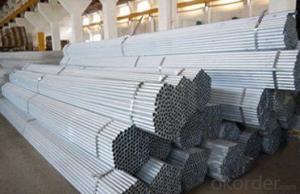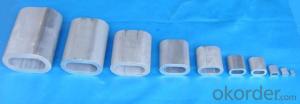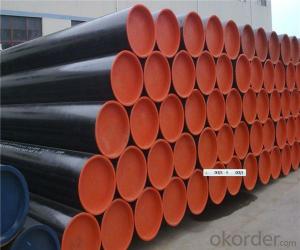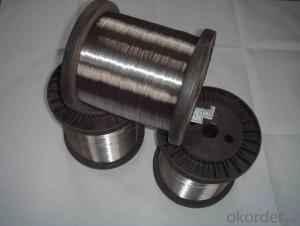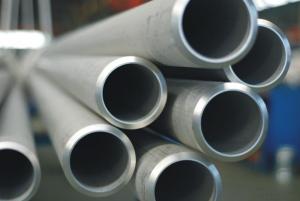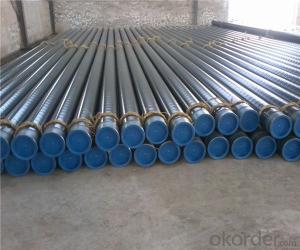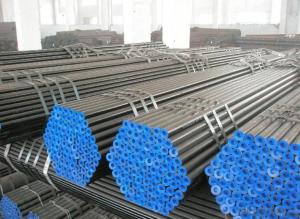Aluminum Sleeve Hot Sale and Good Quality
- Loading Port:
- Shanghai
- Payment Terms:
- TT OR LC
- Min Order Qty:
- 1000 PCS
- Supply Capability:
- 3000000 PCS/month
OKorder Service Pledge
OKorder Financial Service
You Might Also Like
DIN3093 ALUMINUM OVAL SLEEVE FOR STEEL WIRE ROPE
1.Material:aluminum
2.Size:1mm-60mm
3.Type:DIN3093
| DIN3093 ALUMINUM OVAL SLEEVE FOR STEEL WIRE ROPE | |||||
| SIZE | INSIDE WIDTH | INSIDE LENGTH | THICKNESS | LENGTH | WEIGHT |
| MM | MM | MM | MM | MM | KG/1000PCS |
| 1 | 1.2 | 2.4 | 0.65 | 5 | 0.098 |
| 1.5 | 1.7 | 3.45 | 0.75 | 6 | 0.176 |
| 2 | 2.2 | 4.4 | 0.85 | 7 | 0.285 |
| 2.5 | 2.7 | 5.4 | 1.05 | 9 | 0.439 |
| 3 | 3.3 | 6.6 | 1.25 | 11 | 0.907 |
| 3.5 | 3.8 | 7.6 | 1.5 | 13 | 1.18 |
| 4 | 4.4 | 8.8 | 1.7 | 14 | 1.63 |
| 4.5 | 4.9 | 9.8 | 1.9 | 16 | 2.39 |
| 5 | 5.5 | 11 | 2.1 | 18 | 3.62 |
| 6 | 6.6 | 13.2 | 2.5 | 21 | 5.87 |
| 6.5 | 7.2 | 14.4 | 2.7 | 23 | 7.18 |
| 7 | 7.8 | 15.6 | 2.9 | 25 | 9.83 |
| 8 | 8.8 | 17.6 | 3.3 | 28 | 12.96 |
| 9 | 9.9 | 19.8 | 3.7 | 32 | 18.94 |
| 10 | 10.9 | 21.8 | 4.1 | 35 | 24.09 |
| 11 | 12.1 | 24.2 | 4.5 | 39 | 35.35 |
| 12 | 13.2 | 26.4 | 4.9 | 42 | 44.18 |
| 13 | 14.2 | 28.4 | 5.4 | 46 | 59.86 |
| 14 | 15.3 | 30.6 | 5.8 | 49 | 73.5 |
| 16 | 17.5 | 35 | 6.7 | 56 | 111 |
| 18 | 19.6 | 39.2 | 7.6 | 63 | 156 |
| 20 | 21.7 | 43.4 | 8.4 | 70 | 217 |
| 22 | 24.3 | 48.6 | 9.2 | 77 | 292 |
| 24 | 26.4 | 52.8 | 10 | 84 | 376 |
| 26 | 28.5 | 57 | 10.9 | 91 | 481 |
| 28 | 31 | 62 | 11.7 | 98 | 603 |
| 30 | 33.1 | 66.2 | 12.5 | 105 | 739 |
| 32 | 35.2 | 70.4 | 13.4 | 112 | 897 |
| 34 | 37.8 | 75.6 | 14.2 | 119 | 1077 |
| 36 | 39.8 | 79.6 | 15 | 126 | 1275 |
| 38 | 41.9 | 83.8 | 15.8 | 133 | 1503 |
| 40 | 44 | 88 | 16.6 | 140 | 1734 |
| 42 | 46.2 | 92.4 | 17.5 | 147 | 2024 |
| 44 | 48.4 | 96.8 | 18.3 | 154 | 2314 |
| 46 | 50.6 | 101.2 | 19.2 | 161 | 2662 |
| 48 | 52.8 | 105.6 | 20 | 168 | 3010 |
| 50 | 55 | 110 | 20.8 | 175 | 3412 |
| 52 | 57.2 | 114.4 | 21.6 | 182 | 3813 |
| 54 | 59.4 | 118.8 | 22.5 | 189 | 4293 |
| 56 | 61.6 | 123.2 | 23.3 | 196 | 4772 |
| 58 | 63.8 | 127.6 | 24.2 | 203 | 5326 |
| 60 | 66 | 132 | 25 | 210 | 5880 |
Aluminum Sleeve Bushing
Aluminum Sleeve Bushing
Commodity name | aluminum sleeve oval DIN3093 |
Origin | China mainland |
Material | aluminum |
Surface treatment | oxidize |
Process | extrude |
Size | From 1mm inch to 56mm |
M.O.Q | 10-100PCS |
Packing | Gunny bag or polywoven bag or carton and pallet / by customer requirements. |
Delivery time | 15-25 days after order confirmation |
Payment term | T/T, L/C, Western Union |
Business type | Manufacturer, trading |
Certifications | ISO9001,CE |
Advantage | 1. Over 15 years experience of manufacturing and exporting 2. Professional service 3.Competitive price |
Notes | Special specifications and marks can be made according to customers requirements; |
Different function, size and shape available. | |
It is available to produce by customer drawing. | |
Main products | Forging parts, Electric fitting parts, Eye bolt, Turnbuckle, shackles, Link Chain, Hooks, Aluminum sleeve, Thimble, Rigging hardware |
- Q: How do steel pipes handle high-pressure applications?
- Steel pipes are able to handle high-pressure applications due to their inherent strength and durability. The material properties of steel, such as its high tensile strength and resistance to deformation, allow it to withstand the intense pressure exerted on the pipes. Additionally, steel pipes can be manufactured with thick walls and seamless construction, further enhancing their ability to handle high-pressure environments. Overall, the robust nature of steel pipes makes them a reliable choice for various industrial applications requiring high-pressure resistance.
- Q: What is the difference between carbon steel and cast iron pipes?
- Carbon steel and cast iron pipes are both widely used in various industries for different applications. The main difference between these two types of pipes lies in their composition and properties. 1. Composition: Carbon steel pipes are primarily made of iron and carbon, with trace amounts of other elements such as manganese, phosphorus, and sulfur. On the other hand, cast iron pipes are made by melting iron and adding a small amount of carbon, usually between 2-4%. 2. Strength and Durability: Carbon steel pipes are generally stronger and more durable than cast iron pipes. Carbon steel has a higher tensile strength, which means it can withstand higher pressures and is less likely to be damaged or deformed. Cast iron, although strong, is more brittle and prone to cracking. 3. Corrosion Resistance: Carbon steel pipes require additional coatings or treatments to protect them from corrosion. Without proper protection, carbon steel pipes can be susceptible to rust and corrosion, especially when exposed to moisture or aggressive substances. On the other hand, cast iron pipes have inherent corrosion resistance due to the formation of a protective layer of iron oxide (rust) on their surface. 4. Weight and Installation: Cast iron pipes are typically heavier than carbon steel pipes, making them more challenging to handle and install. Carbon steel pipes are comparatively lighter, allowing for easier transportation and installation. 5. Noise and Vibration: Cast iron pipes have superior sound-deadening properties, making them quieter when fluids flow through them. On the contrary, carbon steel pipes tend to transmit more noise and vibrations. 6. Cost: Cast iron pipes are generally more expensive than carbon steel pipes due to the additional manufacturing processes and the higher cost of raw materials. In summary, the main differences between carbon steel and cast iron pipes lie in their composition, strength, corrosion resistance, weight, noise transmission, and cost. The choice between the two depends on the specific application, budget, and environmental factors.
- Q: Why can't stainless steel be put together with carbon steel tube?
- 1, the potential difference is: potential "stainless steel tube" and the negative potential "carbon steel" coupled "stainless steel", "a cathode carbon steel tube" is anode potentials of the two difference the greater the galvanic corrosion is bigger.2. An electronic passage formed by wire connection or direct contact. The carbon in the carbon steel tube loses its electrons to the stainless steel tube and the surface is absorbed by the etchant.3. Electrolyte: the contact area of two metals is covered or submerged by electrolyte. The iron in the carbon tube loses electrons to form ions into the solution, and the electrons on the surface of the stainless steel tubes are taken away by the corrosive agents in the electrolyte (such as oxygen in the air). Electrolytes become ionic channels.
- Q: How are steel pipes used in the manufacturing of automotive exhaust systems?
- Steel pipes are commonly used in the manufacturing of automotive exhaust systems as they possess high strength, durability, and resistance to heat and corrosion. These pipes are used to transport exhaust gases from the engine to the tailpipe, ensuring the safe and efficient operation of the vehicle. They are typically bent and welded together to create a complex network of pipes that helps direct the flow of exhaust gases and reduce noise levels. Overall, steel pipes play a crucial role in the construction of automotive exhaust systems, contributing to their reliability and longevity.
- Q: Can steel pipes be used for oil and gas transportation?
- Yes, steel pipes are commonly used for oil and gas transportation due to their strength, durability, and resistance to corrosion.
- Q: What are the quality control measures for steel pipe manufacturing?
- The quality control measures for steel pipe manufacturing typically include various stages of inspection and testing, starting from raw material evaluation to the final product. These measures may include checking the chemical composition and mechanical properties of the steel, conducting non-destructive testing such as ultrasonic or magnetic particle inspection, monitoring the dimensions and surface finish of the pipes, and ensuring compliance with relevant industry standards and specifications. Additionally, quality control measures may involve regular maintenance and calibration of equipment, rigorous documentation and traceability of processes, and continuous monitoring and improvement of manufacturing techniques to meet the desired quality standards.
- Q: Can steel pipes be used for conveying hydraulic fluids?
- Yes, steel pipes can be used for conveying hydraulic fluids. Steel pipes have high tensile strength and excellent resistance to high pressure, making them suitable for hydraulic applications. They can withstand the high operating pressures and temperature fluctuations that hydraulic systems often experience. Additionally, steel pipes are durable and have a long lifespan, ensuring reliable and efficient fluid transmission in hydraulic systems. However, it is important to ensure that the steel pipes used are compatible with the specific hydraulic fluid being conveyed to prevent corrosion or degradation of the pipe material.
- Q: What is the difference between schedule 10 and schedule 40 steel pipes?
- Schedule 10 and schedule 40 steel pipes are both commonly used in various industries for different purposes. The main difference lies in their wall thickness and pressure ratings. Schedule 10 steel pipes have a thinner wall compared to schedule 40 pipes. This means that schedule 10 pipes have a smaller internal diameter and can handle less pressure compared to schedule 40 pipes. The wall thickness of schedule 10 pipes is typically 0.109 inches, while schedule 40 pipes have a wall thickness of 0.154 inches. Due to their thinner walls, schedule 10 pipes are primarily used for low-pressure applications such as domestic water supply, drainage systems, and general plumbing. They are also commonly used for lightweight structures or where weight is a concern. On the other hand, schedule 40 pipes are designed to handle higher pressure and are often used in industrial applications, including oil and gas pipelines, chemical processing plants, and high-pressure fluid systems. The thicker walls of schedule 40 pipes provide them with increased strength and durability to withstand higher pressure and stress. In summary, the main difference between schedule 10 and schedule 40 steel pipes is their wall thickness and pressure ratings. Schedule 10 pipes have a thinner wall and are suitable for low-pressure applications, while schedule 40 pipes have a thicker wall and can handle higher pressure. It is important to choose the appropriate schedule based on the specific requirements and pressure limitations of the intended application.
- Q: How to make the internal tooth of the steel pipe?
- Cylindrical thread can be used, if the tube is too long, you may consider a short tube with thread, and then welded to the long tube. Taper thread is more difficult to use than ordinary vehicle, and the tap is generally considered. The tap can be clamped on the tailstock.
- Q: How are steel pipes protected against soil movement or settlement?
- Steel pipes can be protected against soil movement or settlement through various methods. One common method is to use protective coatings on the pipes. These coatings act as a barrier between the steel and the soil, preventing direct contact and reducing the risk of corrosion. Some commonly used coatings include epoxy, polyethylene, and zinc. Another method is to use cathodic protection. This involves the installation of sacrificial anodes along the pipeline. These anodes corrode instead of the steel pipes, protecting them from damage caused by soil movement or settlement. Furthermore, proper design and installation techniques can also help protect steel pipes against soil movement or settlement. For instance, engineers may consider factors such as soil composition, slope stability, and potential for ground movement when designing the pipeline route. Additionally, proper trenching and bedding techniques can help ensure that the pipe is adequately supported and protected against settlement. Regular inspection and maintenance are also crucial for protecting steel pipes against soil movement or settlement. Monitoring the condition of the pipeline, including the protective coatings and cathodic protection systems, can help identify any potential issues and allow for timely repairs or replacements. Overall, a combination of protective coatings, cathodic protection, proper design and installation techniques, and regular maintenance can effectively protect steel pipes against soil movement or settlement.
Send your message to us
Aluminum Sleeve Hot Sale and Good Quality
- Loading Port:
- Shanghai
- Payment Terms:
- TT OR LC
- Min Order Qty:
- 1000 PCS
- Supply Capability:
- 3000000 PCS/month
OKorder Service Pledge
OKorder Financial Service
Similar products
Hot products
Hot Searches
Related keywords
